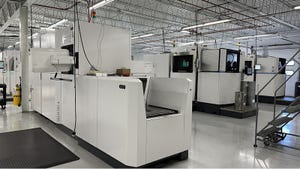August 27, 2010

NationalInstruments' LabVIEW 2010, the latest version of its graphical programmingenvironment for design, test, measurement and control applications, has put thefocus on execution speed. The new release uses off-the-shelf compilertechnologies that run code an average of 20 percent faster, along with acomprehensive marketplace for evaluating and purchasing add-on toolkits toeasily integrate custom functionality into the platform.
"For existing customers, the messagewith LabVIEW 2010 is that code now runs faster," says Rick Kuhlman, the LabVIEW2010 product manager for National Instruments.
LabVIEW 2010 Built for Speed_A |
Key to the productivity delivered by LabVIEWis the compiler which abstracts tasks such as memory allocation and threadmanagement. With the new release, the compiler data flow intermediaterepresentation has been further optimized. Low-Level Virtual Machine (LLVM), anopen source compiler infrastructure, has also been added to the software'scompiler flow to accelerate code execution.
Kuhlman says that of the ways LabVIEW makescode run faster is by introducing an intermediate representation and internaltechniques for creating transformations to the code. When a user hits the "run"button in LabVIEW, it transforms the graphical code into machine code. But nowthe compiler can more fully analyze the graphical code and extract and inferoptimizations.
One example is a common compiler functioncalled "dead code elimination" where a parameter is wired in LabVIEW to a constantparameter that doesn't change. Inside that function, there is code to handleparameter changes which LabVIEW can tell will not be needed.
"LLVM is an open source, low-levelmachine code generator widely used in industry by companies such as Adobe,Apple and Google," says Kuhlman. "LabVIEW 2010 uses LLVM for its knowledgeof the hardware and how to best utilize new chips and their optimized instructionsets. LLVM is especially well-suited for LabVIEW, because LabVIEW executes onmany platforms including Intel, PowerPC and ARM processors."
For field-programmable gate array (FPGA)users, LabVIEW 2010 delivers a new IP Integration Node that makes it possibleto integrate any third-party FPGA IP into LabVIEW applications and iscompatible with the Xilinx CORE Generator. National Instruments alsoimplemented more than a dozen new features suggested by lead users through theLabVIEW Idea Exchange, an online feedback forum that marks a significant newlevel of collaboration between NI R&D and customers.
"With LabVIEW 2010, there are also manycommunity features," says Kuhlman. "We have been focusing on being able to takeproduct development ideas from our very active community of users, and actuallyimplement the ideas in LabVIEW."
In 2009, National Instruments started promotingthe Idea Exchange as an online forum to gather ideas fromcustomers. Customers submitted 1,300 ideas,and 27,000 people voted on those ideas.
"It's been an active forum and, during thattime, some ideas came to the top and were actually put into LabVIEW as productfeatures," says Kuhlman. "We interviewed some of the idea makers that submittedthese ideas, and they were surprised and honored that some of their exactfeatures were implemented in LabVIEW."
Click here to learn more about LabVIEW2010 or download evaluation software.
About the Author(s)
You May Also Like






